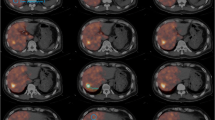Abstract
Purpose
Exclusive and homogeneous perfusion of the liver is considered essential for the efficacy of hepatic arterial infusion of chemotherapy (HAI). The aim of this study was to evaluate port perfusion scintigraphy in colorectal cancer patients using a hybrid SPECT-CT system for control of minimally invasive intra-arterial port systems within the scope of a phase II trial.
Methods
In 24 consecutive patients, the perfusion territories of intra-arterial hepatic port systems were assessed by port scintigraphy with 99mTc-labelled macroaggregated albumin employing planar imaging, SPECT and SPECT-CT (acquired with a hybrid SPECT-CT camera). The results of blinded reading of the scintigraphic modalities concerning the intra- and extrahepatic perfusion pattern were compared with combined image analysis (angiography and contrast-enhanced dedicated CT) and patient history for validation.
Results
Extrahepatic perfusion was correctly seen in three patients, while suspected extrahepatic perfusion could be excluded in one. In 46 liver lobes, perfusion patterns were correctly visualised by SPECT-CT in 100% of cases (planar, 67%; SPECT, 86%). Assessing the perfusion pattern inside the liver on a segmental basis (segments, n=138), SPECT-CT revealed correct segmental assignment of tracer distribution in 100% and was significantly superior to SPECT alone (accuracy, 84%; p<0.001). The scintigraphic findings resulted in changes in therapeutic management in 8/24 patients (33%); in two of these the relevant findings were visualised only by SPECT-CT.
Conclusion
In patients receiving HAI, port perfusion scintigraphy by fusion imaging with a hybrid SPECT-CT system provides important information for therapy optimisation and appears to be superior to SPECT alone.




Similar content being viewed by others
References
Cohen AD, Kemeny NE, Saltz LB. An update on hepatic arterial infusion chemotherapy for colorectal cancer. Oncologist 2003;8:553–66.
Harmantas A, Rotstein LE, Langer B. Regional versus systemic chemotherapy in the treatment of colorectal carcinoma metastatic to the liver. Is there a survival difference? Meta-analysis of the published literature. Cancer 1996;78(8):1639–45.
MACG (Meta Analyses Group in Cancer). Reappraisal of hepatic arterial infusion in the treatment of nonresectable liver metastases from colorectal cancer. J Natl Cancer Inst 1996;88:252–8.
Ricke J, Hildebrandt B, Miersch A, Nicolaou A, Warschewske G, Teichgraber U, et al. Hepatic arterial port systems for treatment of liver metastases: factors affecting patency and adverse events. J Vasc Interv Radiol 2004;15(8):825–33.
Herrmann KA, Waggershauser T, Sittek H, Reiser MF. Liver intraarterial chemotherapy: use of the femoral artery for percutaneous implantation of catheter-port systems. Radiology 2000;215:294–9.
Sadahiro S, Suzuki T, Ishikawa K, Yasuda S, Tajima T, Makuuchi H, et al. Prophylactic hepatic arterial infusion chemotherapy for the prevention of liver metastasis in patients with colon carcinoma: a randomized control trial. Cancer 2004;100:590–7.
Lehner K, Reiser M, Gebhardt U, Heuck A, Schaff J. DSA control of implanted devices for arterial hepatic perfusion. Cardiovasc Interv Radiol 1987;10(2):71–4.
Lubin E, Cyjon A, Neuman M. Technetium-99m macroaggregates for the study of the distribution of arterial infusion chemotherapy in the liver. Clin Nucl Med 1987;12(5):385–8.
Puls R, Stroszczynski C, Hildebrandt B, Hosten N, Bechstein WO, Riess H, et al. Imaging of intra-arterial hepatic port catheter systems by power-Doppler sonography using contrast media—preliminary results. Ultraschall Med 2000;21(4):176–9.
Morimoto M, Satake M, Sekiguchi R, Haruno M, Moriyama N. Optimal injection protocol for CT evaluation during hepatic arterial infusion chemotherapy. Invest Radiol 1999;34(12):744–50.
Seki H, Ozaki T, Takaki S, Ooi H, Oda J, Shiina M. Using slow-infusion MR arteriography and an implantable port system to assess drug distribution at hepatic arterial infusion chemotherapy. Am J Roentgenol 2003;180(3):681–6.
Allen PJ, Stojadinovic A, Ben-Porat L, Gonen M, Kooby D, Blumgart L, et al. The management of variant arterial anatomy during hepatic arterial infusion pump placement. Ann Surg Oncol 2002;9:875–80.
Bocher M, Balan A, Krausz Y, Shrem Y, Lonn A, Wilk M, et al. Gamma camera-mounted anatomical X-ray tomography: technology, system characteristics and first images. Eur J Nucl Med 2000;27(6):619–27.
Pelosi E, Bar F, Battista S, Bello M, Bucchi MC, Alabiso O, et al. Hepatic arterial infusion chemotherapy for unresectable confined liver metastases: prediction of systemic toxicity with the application of a scintigraphic and pharmacokinetic approach. Cancer Chemother Pharmacol 1999;44(6):505–10.
Ziessman HA, Wahl RL, Juni JE, Gyves JE, Ensminger WD, Thrall JH, et al. The utility of SPECT for 99mTc-MAA hepatic arterial perfusion scintigraphy. Am J Roentgenol 1985;145(4):747–51.
Suzuki Y, Kobayashi S, Yasuda S. Application of single-photon emission computed tomography (SPECT) with 99mTc-MAA in evaluation of perfusion patterns during hepatic infusion chemotherapy. Ann Nucl Med 1991;5(3):123–6.
Amthauer H, Denecke T, Rohlfing T, Ruf J, Bohmig M, Gutberlet M, et al. Value of image fusion using single photon emission computed tomography with integrated low dose computed tomography in comparison with a retrospective voxel-based method in neuroendocrine tumours. Eur Radiol 2004;[Epub ahead of print].
Ruf J, Lopez Hanninen E, Steinmuller T, Rohlfing T, Bertram H, Gutberlet M, et al. Preoperative localization of parathyroid glands. Use of MRI, scintigraphy, and image fusion. Nuklearmedizin 2004;43(3):85–90.
Amthauer H, Ruf J, Bohmig M, Lopez-Hanninen E, Rohlfing T, Wernecke KD, et al. Diagnosis of neuroendocrine tumours by retrospective image fusion: is there a benefit? Eur J Nucl Med Mol Imaging 2004;31(3):342–8.
Author information
Authors and Affiliations
Corresponding author
Rights and permissions
About this article
Cite this article
Denecke, T., Hildebrandt, B., Lehmkuhl, L. et al. Fusion imaging using a hybrid SPECT-CT camera improves port perfusion scintigraphy for control of hepatic arterial infusion of chemotherapy in colorectal cancer patients. Eur J Nucl Med Mol Imaging 32, 1003–1010 (2005). https://doi.org/10.1007/s00259-005-1794-z
Received:
Accepted:
Published:
Issue Date:
DOI: https://doi.org/10.1007/s00259-005-1794-z




